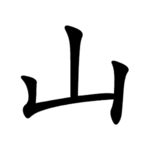Radical 46
| ||
| Pronunciations | ||
| Pinyin: | shān | |
| Bopomofo: | ㄕㄢ | |
| Gwoyeu Romatzyh: | shan | |
| Wade–Giles: | shan1 | |
| Cantonese Yale: | sāan | |
| Jyutping: | saan1 | |
| Pe̍h-ōe-jī: | san | |
| Japanese Kana: | サン san (on'yomi) やま yama (kun'yomi) | |
| Sino-Korean: | 산 san | |
| Names | ||
| Chinese name(s): | (Left) (Top) (Bottom) | |
| Japanese name(s): | (Left) (Top) | |
| Hangul: | 메 me | |
| Stroke order animation | ||
 | ||
Radical 46 or radical mountain (
In the Kangxi Dictionary, there are 636 characters (out of 49,030) to be found under this radical.
In Taoist cosmology,
Evolution
[edit]-
Oracle bone script character
-
Bronze script character
-
Large seal script character
-
Small seal script character
| Strokes | Characters |
|---|---|
| +0 | |
| +1 | 乢 (= |
| +2 | 屳 屴 屵 屶JP (also obsolete variant form of |
| +3 | 屸 屹 屺 屻 屼 屽 屾 屿SC (=嶼) 岀 (= |
| +4 | 岄 岅 (= |
| +5 | 岝 岞 岟 岠 |
| +6 | 岍 峆 峇 峈 峉 峊 峋 峌 峍 峎 峏 峐 峑 峒 峓 峔 峕 (= |
| +7 | 峨 峩 (=峨) 峪 峫 峬 峭 峮 |
| +8 | 崆 |
| +9 | 崱 崲 崳 崴 崵 崶 崷 崸 崹 崺 崻 (=峙) 崼 崽 崾 崿 嵀 嵁 嵂 嵃 嵄 嵅 嵆 嵇 嵈 嵉 嵋 |
| +10 | 嵊 嵞 嵟 嵠 嵡 嵢 嵣 嵤 嵥 嵦 嵧 嵨 |
| +11 | 嵷 嵸 嵹 嵺 嵻 嵼 嵽 嵾 嵿 嶀 嶁 嶂 嶃 (=嶄) 嶄 嶅 嶆 嶇 嶈 嶉 嶊 |
| +12 | 嶏 嶐 嶑 嶒 嶓 嶔 嶕 嶖 嶗 嶘 嶙 嶚 (=嶛) 嶛 嶜 嶝 嶞 嶟 嶠 嶡 嶢 嶣 嶤 嶥 |
| +13 | 嶦 嶧 嶨 嶩 (=峱) 嶪 嶫 嶬 嶭 嶮 嶯 嶰 嶱 嶲 嶳 嶴 嶵 嶶 |
| +14 | 嶷 嶸 嶹 |
| +15 | 巀 巁 巂 |
| +16 | 嶻 巃 巄 (=巃) 巅SC (=巔) |
| +17 | 巆 巇 巈 巉 巊 巋 |
| +18 | |
| +19 | 巎 巑 巒 巓 (=巔) 巔 巕 巗 (= |
| +20 |
Sinogram
[edit]The radical is also used as an independent Chinese character. It is one of the kyōiku kanji or kanji taught in elementary school in Japan.[1] It is a first grade kanji.[1]
References
[edit]- ^ a b "The Kyoiku Kanji (
教育 漢字 ) - Kanshudo". www.kanshudo.com. Archived from the original on March 24, 2022. Retrieved 2023-05-06.
Literature
[edit]- Fazzioli, Edoardo (1987). Chinese calligraphy : from pictograph to ideogram : the history of 214 essential Chinese/Japanese characters. calligraphy by Rebecca Hon Ko. New York: Abbeville Press. ISBN 0-89659-774-1.
- Lunde, Ken (Jan 5, 2009). "Appendix J: Japanese Character Sets" (PDF). CJKV Information Processing: Chinese, Japanese, Korean & Vietnamese Computing (Second ed.). Sebastopol, Calif.: O'Reilly Media. ISBN 978-0-596-51447-1.




